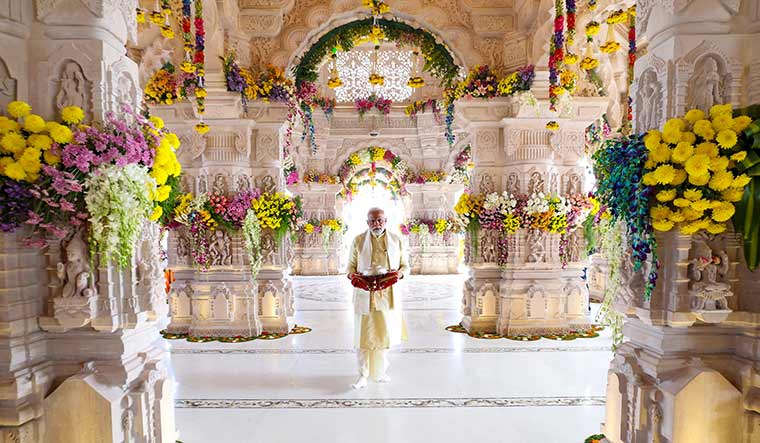In India’s political history, 1984 was epochal. It was the year prime minister Indira Gandhi was assassinated. It was also the year the four-year-old BJP found itself in an existential crisis—it could win only two seats in the Lok Sabha polls held after Indira’s death. For years, the party had to endure taunts of getting seats equivalent to the family planning norms of the day. Forty years later, though, the tide is set to turn, as Narendra Modi prepares to become the first non-Congress prime minister to win a third term.
Unlike the 2019 elections, when the government had to pitch in with an election-oriented interim budget, the euphoria around the consecration of the Ram Temple in Ayodhya has the BJP in a comfortable position. The sentiment has huge potential to turn into votes; also, Ram Navami in April could act as another call to the faithful.
With the Modi government’s development pitch and its massive outreach to more than 80 crore beneficiaries of Central government schemes, the BJP has a big lead in getting its messaging to key target groups—women, youth, poor and farmers. Also helping the party is the fact that the opposition is yet to set an emphatic narrative, and is even showing signs of unravelling.
The outcome of assembly polls in three states in December had shown that, with its organisational strength, the BJP could even turn voter apathy after years of rule—as in Madhya Pradesh—into a comprehensive victory. At the instance of Amit Shah, Union home minister and the party’s main strategist, the BJP had devised innovative schemes, such as the one that involved establishing an institutionalised system to make calls to wake up booth-level workers and functionaries early in the morning on polling day. This was to activate them into getting voters to booths and carry out other tasks. Shah’s mantra: win the booth, win the seat.
For the Lok Sabha campaign, booth-level workers have been given a target—get 50 per cent of votes in their respective booths. For their part, Modi, Shah, party president J.P. Nadda and other senior leaders will talk about ‘Modi Guarantee’.
The slogan has good recall value, and it was successfully tested in the assembly polls in Rajasthan, Madhya Pradesh and Chhattisgarh. “Modi Guarantee means that 80 crore people, who were neglected by earlier governments, were given houses, gas, power, food, water, medicines…. Modi Guarantee means that everyone in this country has a right to live a good life, which is the spirit of our Constitution,” Shah said.
It was after serving as party president for five years that Shah became home minister. Yet he continues to do party work. “Working for the party is akin to breathing,” he said. Shah understands the importance of party work, as he started as an ordinary worker pasting posters. Painting graffiti on walls is now an institutionalised process in the party’s election campaign. The BJP launched its graffiti campaign for the Lok Sabha polls on January 15, showing that while social media may dominate the narrative, old-fashioned campaigning remains essential in creating a favourable atmosphere.
The last 10 years have been significant for the country, as they marked a pronounced shift towards matters of faith. Cultural nationalism is now a dominant theme, especially in the Hindi heartland. The decision to implement the Uniform Civil Code in Uttarakhand has given a signal that it has ticked off all promises in its election manifesto. Other states where the BJP is in power may follow suit.
The challenge before the BJP is to increase its seats in the east and the south, which has big states like West Bengal, Bihar, Odisha, Tamil Nadu, Telangana and Andhra Pradesh. The party has always performed well in the Lok Sabha polls in Karnataka. The enhanced vote share in the Telangana assembly elections has given the party hopes of increasing its Lok Sabha tally from four seats.
Renewed alliances with the Janata Dal (Secular) in Karnataka and the Janata Dal (United) in Bihar have opened possibilities of the return of the Shiromani Akali Dal, the Telugu Desam Party and the AIADMK to the BJP-led National Democratic Alliance fold (NDA). During the 2019 polls, when the NDA included Bihar Chief Minister Nitish Kumar’s JD(U), it had won 39 of 40 seats in the state. Nitish’s return to the saffron fold is being attributed to the growing support for the BJP after the Ram Temple consecration, and his own experience at the hustings. The JD(U) had won 16 seats in 2019 and just two in 2014, when it was not part of the NDA.
A similar ‘engineering’ in Maharashtra has the BJP at an advantage. In 2019, the NDA comprising the BJP and the Shiv Sena had won 48 seats in the state. The NCP had won four. Now the dominant breakaway groups of the Shiv Sena and the NCP are with the NDA. The dissension within the INDIA bloc in West Bengal is good news for the BJP. Together, these four states—Bihar, Maharashtra, West Bengal and Karnataka—account for 158 Lok Sabha seats.
The BJP is also banking on increasing its tally in Odisha, where Chief Minister Naveen Patnaik is preparing to set a record for being the longest serving chief minister in the country (fewer than 200 days remain for him to achieve the target). The BJP’s tribal outreach efforts are also set to reap dividends in Chhattisgarh and Jharkhand.
The Modi government has also ticked another crucial box by conferring Bharat Ratna to two leaders representing the two dominant political streams in the country—Karpoori Thakur, former Bihar chief minister who championed social justice, and L.K. Advani, the original flag-bearer of the hindutva and Ram Temple movement. At the ground level, it is the merger of Mandal and Kamandal politics.


